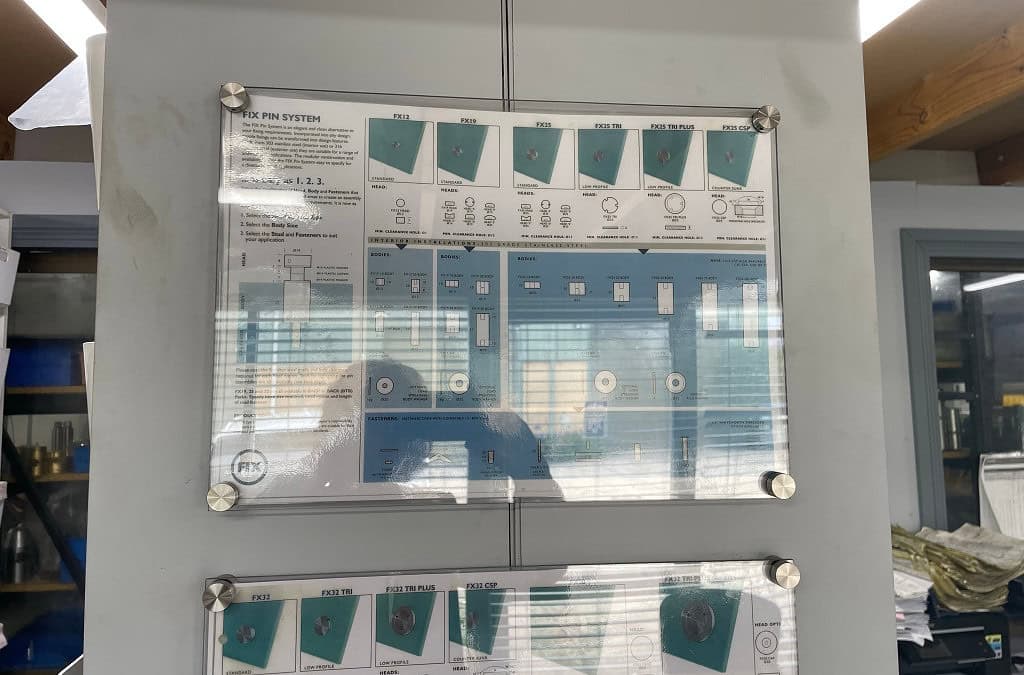Have you ever stood before a magnificent artwork in the outdoors, its sleek glass facade reflecting the brilliance of the sun, and felt a sense of wonder? Glass, with its transparency and modern allure, has become an iconic symbol of architectural innovation, transforming modern designs worldwide. Yet, behind the beauty lies a crucial aspect: structural support.
So how do you support a glass facade? Standoff fixing systems are the gold standard. Their unparalleled combination of strength, versatility, and aesthetic adaptability makes them the premier choice for architects and engineers seeking to achieve both structural integrity and visual elegance. Other options include structural glass systems, frame systems, cable net structures, glass fins, and tension rod systems.
Why standoff systems are the best option for glass facades
Standoff systems are increasingly recognised as an optimal solution for glass facades due to several compelling reasons. These systems, which involve the use of spacers or “standoffs” to hold glass panels in place, offer a blend of aesthetic appeal, structural integrity, and flexibility. Here’s why they are considered the best option for glass facades:
Aesthetic Appeal
Standoff systems provide a clean, modern look that is highly sought after in contemporary architecture. By minimising visible hardware, they allow for an unobstructed view through the glass, enhancing the facade’s transparency and sleek appearance.
Structural Integrity
Standoffs are typically made from materials like stainless steel, which are resistant to corrosion, weathering, and wear. This makes them suitable for use in a wide range of environmental conditions, ensuring long-term stability and performance.
Flexibility and Ease of Installation
Standoff systems allow for minor adjustments during installation, making it easier to align glass panels precisely. This flexibility can be crucial in achieving the perfect fit and finish, especially in complex facade designs.
The modular nature of standoff systems also means that individual glass panels can be easily removed and replaced if damaged, without the need to dismantle the entire facade.
Pro tip
Although the initial investment in standoff systems might be higher compared to traditional mounting methods, their durability, and ease of maintenance can lead to significant savings over the lifespan of the facade.
Other common methods for glass facade support
1. Structural glass systems
Structural glass systems, or structural glazing, involve the use of glass panels as the main structural component, supported by minimal hardware or sealant. This method eliminates the need for traditional framing, resulting in a seamless, all-glass appearance.
- Advantages: Maximises natural light and provides uninterrupted views. The lack of visible framing contributes to a modern and sleek aesthetic. It’s also highly customisable to fit various architectural styles.
- Applications: High-end commercial buildings, storefronts, atriums, and in any context where an unobstructed view is desired.
2. Frame systems
Frame systems utilise a metal framework to support glass panels. The frame can be made from materials like aluminium, steel, or timber, and is designed to hold the glass in place securely.
- Advantages: Provides structural strength and is adaptable to different sizes and shapes of buildings. The frames can also contribute to the aesthetic appeal of the building, with a range of finishes and colours available.
- Applications: Widely used in commercial and residential buildings for exterior and interior facades, windows, and doors.
3. Cable net structures
Cable net structures use a tensioned network of cables to support glass panels, creating a lightweight and flexible facade system. The glass is typically attached to the cables using clamps or connectors.
- Advantages: Allows for the creation of large, free-form glass surfaces without the need for traditional framing. The system is visually striking and can support dynamic architectural expressions.
- Applications: Ideal for large atriums, exhibition spaces, and buildings requiring an innovative architectural approach.
4. Glass fins
Glass fins are vertical support elements made of glass, used to provide lateral support to large glass panels. They can be used in conjunction with other support systems, like structural glazing or cable nets.
- Advantages: Enhances the structural performance of glass facades while maintaining a high degree of transparency. Glass fins can also serve as a decorative element, adding to the facade’s aesthetic appeal.
- Applications: Storefronts, curtain walls, and any application where additional support for large glass panels is needed without compromising on transparency.
5. Tension rod systems
Tension rod systems consist of rods or cables in tension, used to support glass panels either directly or indirectly. These systems often work in conjunction with other structural elements like frames or glass fins.
- Advantages: Provides a minimalist support structure that is visually less intrusive than traditional frames. It’s flexible and can be adapted to a variety of architectural styles.
- Applications: Facades, canopies, and atriums in both commercial and residential buildings, especially where a delicate, almost floating appearance is desired.
How to choose the most appropriate system for your facade
Picking the perfect system for your glass facade is like a puzzle with tons of pieces, and each piece needs to fit just right for the whole thing to look and function flawlessly.
Collaboration between experts is key because it combines different skills and perspectives, leading to smarter, safer, and more creative facade solutions. It helps spot and solve problems early, saving time and money while ensuring the project meets all regulations and performs well in the long run.
You’ve got architects who are all about the aesthetics and design, engineers who dive deep into the technical side of things, and maybe even sustainability experts who want to ensure your facade is eco-friendly. When you bring all these brains together, magic happens.
When professionals from different fields work together, they can combine their knowledge in innovative ways, leading to creative solutions that might not have been discovered in siloed environments. This cross-pollination of ideas can push the boundaries of traditional design and engineering to achieve breakthroughs in facade systems.
A multidisciplinary approach not only meets the immediate needs of the project but also ensures its long-term viability and success.
FIX standoff systems are made from high-strength, corrosion-resistant materials
When it comes to choosing the right system for your glass facade, FIX standoff systems stand out as a top contender. They’ve got what it takes to weather the elements and keep your facade looking sharp for the long haul. Whether you’re aiming for a sleek, contemporary aesthetic or a more timeless design, these systems are versatile and can adapt to suit your vision.
If you’re after a facade solution that’s both robust and flexible, we’ve got what you need. Our standoff fixings combine strength, style, and ease of installation, making them a smart choice for any project. Find the right standoff for your glass facade today.
Phone
We deliver standoff fixings to homeowners, designers, and commercial business owners across the world. Whether you’re in Australia or overseas, we have the architectural hardware to fit your needs.

